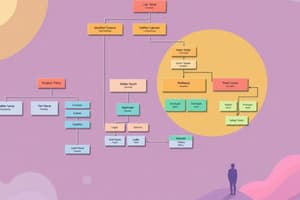Podcast
Questions and Answers
What is the primary purpose of a flowchart in business processes?
What is the primary purpose of a flowchart in business processes?
- To document financial transactions.
- To create software applications.
- To organize and visualize the steps in a process. (correct)
- To conduct market analysis.
Which direction should a flowchart ideally read?
Which direction should a flowchart ideally read?
- Bottom to top and left to right.
- Top to bottom and left to right. (correct)
- Right to left and top to bottom.
- Random order based on the process.
What should be included when creating a flowchart for clarity?
What should be included when creating a flowchart for clarity?
- Colors to denote different processes.
- A legend explaining all symbols used. (correct)
- Detailed descriptions of each step only.
- Only the major steps in the process.
What type of diagram would best represent the data flow in a system?
What type of diagram would best represent the data flow in a system?
When should page connectors be used in a flowchart?
When should page connectors be used in a flowchart?
What is a primary reason for documenting systems in accounting?
What is a primary reason for documenting systems in accounting?
What is the purpose of a Business Process Diagram (BPD)?
What is the purpose of a Business Process Diagram (BPD)?
Which notation is used for standard representation in a Business Process Diagram?
Which notation is used for standard representation in a Business Process Diagram?
What is an essential step in drawing Data Flow Diagrams (DFDs)?
What is an essential step in drawing Data Flow Diagrams (DFDs)?
What should be considered while deciding the level of detail in a Data Flow Diagram?
What should be considered while deciding the level of detail in a Data Flow Diagram?
Which of the following is NOT a guideline for drawing Data Flow Diagrams?
Which of the following is NOT a guideline for drawing Data Flow Diagrams?
In a Business Process Diagram, what can the diagram show about an activity?
In a Business Process Diagram, what can the diagram show about an activity?
How can a Business Process Diagram assist auditors?
How can a Business Process Diagram assist auditors?
What is one of the key strengths of using flowcharts in an information system?
What is one of the key strengths of using flowcharts in an information system?
Which type of flowchart shows the flow of documents and data for evaluating internal controls?
Which type of flowchart shows the flow of documents and data for evaluating internal controls?
Data Flow Diagrams (DFDs) primarily focus on which of the following?
Data Flow Diagrams (DFDs) primarily focus on which of the following?
What should you do first when drawing a flowchart?
What should you do first when drawing a flowchart?
Which of the following is not normally depicted in flowcharts?
Which of the following is not normally depicted in flowcharts?
In a flowchart, what does a decision step typically represent?
In a flowchart, what does a decision step typically represent?
What is a primary characteristic of Data Flow Diagrams?
What is a primary characteristic of Data Flow Diagrams?
Which of the following is a type of flowchart that illustrates the sequence of logic in a system process?
Which of the following is a type of flowchart that illustrates the sequence of logic in a system process?
Study Notes
System Documentation Technique
- Accountants need to be able to read system documentation and understand how a system works.
- The Sarbanes-Oxley Act (SOX) requires companies to assess internal controls and auditors to evaluate those assessments.
- System documentation is used during system development and for making changes to a system.
Business Process Diagrams
- Business Process Diagrams (BPD) are visual representations of activities in a business process.
- BPD's are designed to be easily understood by all business users using a standard notation, BPMN: Business Process Modeling Notation.
- BPD's can include the organizational unit performing a given activity.
Data Flow Diagrams (DFD)
- DFD's focus on the data flows in processes, the sources and destinations of data, and data stores.
- DFD's are visually simple and can be used to represent the same process at both a high-level and in detail.
Flowcharts
- Flowcharts describe an information system by showing inputs and outputs, information activities, data storage, data flows, and decision steps.
- Flowcharts are effective at capturing control via decision points and showing manual vs. automated processes.
Types of Flowcharts
- Document flowcharts: show the flow of documents and data in a process, and aid in evaluating internal controls.
- System flowcharts: depict the data processing cycle of a given process.
- Program flowcharts: illustrate the sequence of logic in a system process.
Guidelines for Drawing Flowcharts and DFD's
-
Flowcharts
- Understand the system you are trying to represent.
- Identify business processes, documents, data flows, and data processing procedures.
- Organize the flowchart to read from top to bottom and left to right.
- Clearly label all symbols.
- Use page connectors if the diagram cannot fit on a single page.
- Edit, review, and refine the flowchart to make it easy to read.
-
DFD's
- Identify and understand the business process.
- Decide the level of detail (summary or detailed DFD).
- Organize using as many rows as needed to explain the process.
- Enter each business process showing where it begins and ends.
- Draw a rough sketch, refine, and finalize.
Key Terms
- Documentation
- Narrative description
- Business process diagram (BPD)
- Flowchart
- Document flowcharts
- Internal control flowcharts
- System flowchart
- Program flowchart
- Data flow diagram (DFD)
- Data source
- Data destination
- Data flow
- Processes
- Data store
- Context diagram
Studying That Suits You
Use AI to generate personalized quizzes and flashcards to suit your learning preferences.
Related Documents
Description
This quiz explores key concepts related to system documentation techniques, business process diagrams, data flow diagrams, and flowcharts. Understand how these tools enhance the comprehension of system operations and support compliance with regulations such as the Sarbanes-Oxley Act. Test your knowledge on how these diagrams represent processes and data flows in various business environments.




